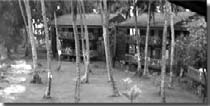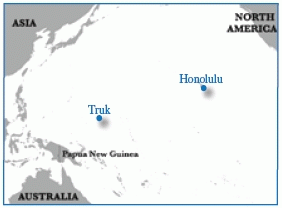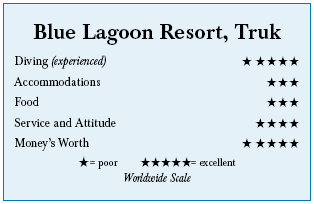Blue Lagoon Resort, Truk, MicronesiaContents of this Issue: We Want Your Tips About Tipping Fire Sinks Amigos Del Mar’s Dive Boat Blue Lagoon Resort, Truk, Micronesia New Travel Rules for Dive Gear Batteries Why Technical Training is Worth Your Time A Major Risk: When the Dive Operator Doesn’t Take Plastic Unusual Scuba Fins, Part II: Force Fins Those Guides Who Manhandle Fish Editorial Office: Ben Davison Publisher and Editor Undercurrent 3020 Bridgeway, Suite 102 Sausalito, CA 94965 WWII wrecks worthy of technical dive training from the February, 2008 issue of Undercurrent
Dear Fellow Diver: When it comes to wreck diving, Truk Lagoon (officially Chuuk) in Micronesia is consistently rated the top destination on Earth. Always more of an explorer than a fish gazer, I had put it off because my tall frame dreaded the numerous flights required to get there. Furthermore, while many of my wreck-diving friends had headed for liveaboard diving, I preferred the freedom associated with a land-based operation. As it turned out, the Blue Lagoon Resort was just the right choice. U.S. Operation Hailstone devastated Japanese shipping in February 1944. Scattered across a warm, clear-water, 40-mile-wide lagoon are scores of sunken Japanese warships, submarines and freighters, as well as a few downed American planes. Salvage operations were few, and the graveyard remains intact, slowly deteriorating with the passing of time. You can dive Truk with a basic openwater certification, but it’s like visiting the world’s best golf course and then only playing nine holes. Because many wrecks are deeper than 130 feet, it’s safer to have technical dive training and experience. Although the expense and gear requirements are considerable, I went for the training, which I spaced over several months. Another good choice. And I knew my trip was worth it when I gazed at the Fujikawa Maru, a 435-foot carrier that is one of the shallowest wrecks, sitting at 110 feet. Gliding into the holds, I discovered infamous Japanese Zero fighters, hundreds of medicine bottles, torpedoes and other ammunition. The engine room came alive with swirling fish that glimmered in my dive light. A side tour brought me into the workshop where abandoned tools have lain scattered since the ship sank. Returning to the engine room, overhead ambient light illuminated a row of massive cylinder heads like pews in a church. The subaquatic time capsule was a true testament to the ravages of naval warfare that is obsolete today. I wasn’t so sure Truk would be worth my trouble, after being cramped in several planes for 14 hours and laying over in two airports for hours. But as soon as I arrived, Blue Lagoon staff whisked me away for a 30-minute drive along potholed jungle roads to the self-contained haven. There I found space to stretch out in my cathedralceilinged room, with a small fridge. My bathroom measured the same size as most liveaboard cabins, and my balcony had excellent water views and clothes-hanging capacity. Blue Lagoon’s tidy grounds featured a large restaurant, activities room and outdoor bar shaded by lush coconut trees, not the confines of a liveaboard.
At the dive shop, my buddy and I met our designated dive guide Chenny, an experienced veteran, and our panga driver, Jongky. The shop had an impressive collection of compressors to fill air and nitrox tanks but dive gear and spare parts were sparse, so I was glad I carried extra batteries and essentials. A small fleet of pangas sat ready for the day’s dives. They looked rustic with their plywood sun covers, and simple wooden benches served as storage area for cameras and dry goods. But they sped us to the wrecks in 10- to 20-minute commutes. I didn’t have to lug my gear back and forth every day because wash tanks and lockers at the neighboring dock made the daily routine simple. Another diver joined us for the first
three days. We had the boat to ourselves the
final four. Since our new mate was only a single
tank diver, we started off with the shallower
wrecks and worked our way deeper. Shunning GPS, Chenny found the wrecks by dead reckoning. He and Jongky were socially reserved fellows and dive briefings were indeed brief, but Chenny always got us to the best parts of the wreck. He didn’t herd us, but his pace was occasionally too quick for my paparazzi-shooting buddy. For technical dives, we determined our own time, depth and decompression, and for safety an extra tank and hang bar were 15 feet beneath the panga. After gearing up and taking a back roll, I followed Chenny down the anchor line. Most wrecks were freighters (‘Maru’ in Japanese) laden with war supplies -- planes, tanks, tractors, torpedoes, ammunition and medical supplies. Large openings on the deck revealed the cargo holds, and I could often fin from one hold to the next. With open skylights above, the engine rooms’ nooks and crannies were easy to explore. I made a second trip to the Fujikawa Maru to visit its lower engine room. The chamber was crammed with catwalks, pipes, valves and instrument panels forever frozen in time. In the following days, I explored the lower engine room in the Rio de Janeiro at 95 feet, which featured a hold of beer bottles, and army tanks on the San Francisco, still fully loaded with cargo at 185 feet. I discovered ornate china cabinets and torpedoes in the Heian, road-building tractors and tow tractors in the Hoki’s holds at 150 feet, and the Kansho’s galley, whose oven still held its massive wok. My deepest dive was 208 feet to see the Aikoku’s propellers. I spent 18 minutes at depth and the entire dive, including decompression, was an hour and 18 minutes. PS: While most human remains had been removed by the Japanese Navy and cremated in the 1990s, I still saw bones in many wrecks.
Wreck diving -- ok, all diving -- worked up an appetite. While I might sample the local eggs and fish breakfast (you can order fried Spam, a staple in Micronesia since the GI’s arrived), my buddy managed quite well with oatmeal or fried rice. For lunch, the box lunch wouldn’t satisfy a hungry diver so I headed to the restaurant, which served a broad blend of local island food, Chinese, Italian, and American –- pork adobo, saimin, spaghetti, fried or baked chicken –- filling, adequate and less than $10. Seafood –- fish and chips, tuna steak -- was plentiful and my vegetarian dive buddy survived without complaint. Unlike being on a liveaboard, I had a full restaurant menu to choose from. The only entertainment was a stack of old videos at the front desk – room TVs didn’t work – so bring a thick book. During a decompression stop far above the Hoki Maru, I discovered my cherished dive light was gone. It had come unclipped from a D-ring in the mangled wreckage 133 feet below. After lunch, I asked to dive again on the Hoki to find my light, a request -quickly granted because only two of us were assigned to the boat, and, lo and behold, I found my light. I now double-clip it. Don’t avoid Truk if you’re not a technical diver; sport divers have been thrilled here for years, especially WWII history buffs. Blue Lagoon, which can handle up to 100 divers and a range of skills, will set up dives to meet your needs. After all, this is where Truk wreck diving began and though the original owner, Kimiuo Aisek who witnessed the attack on Truk, has passed, his son Gradvin runs the diving and daughter Gardenia runs the hotel. But if you have the opportunity, do consider technical training. I found it well worth the time and trouble, as you may have gathered by now. And my decision to stay on land was the right one. It hit me one night when a group of raucous Brits from the Odyssey came to Blue Lagoon’s restaurant for their last night. “Could you imagine being on board with that group for a week?” asked my buddy. No, I couldn’t. -- M.V.
|

I want to get all the stories! Tell me how I can become an Undercurrent Online Member and get online access to all the articles of Undercurrent as well as thousands of first hand reports on dive operations world-wide
| Home | Online Members Area | My Account |
Login
|
Join
|
| Travel Index |
Dive Resort & Liveaboard Reviews
|
Featured Reports
|
Recent
Issues
|
Back Issues
|
|
Dive Gear
Index
|
Health/Safety Index
|
Environment & Misc.
Index
|
Seasonal Planner
|
Blogs
|
Free Articles
|
Book Picks
|
News
|
|
Special Offers
|
RSS
|
FAQ
|
About Us
|
Contact Us
|
Links
|
3020 Bridgeway, Ste 102, Sausalito, Ca 94965
All rights reserved.


 By the time he left, we were ready to run technical
dives with double tanks for more bottom time.
Nitrox 50 sling tanks, clipped to my BCD,
made decompression times briefer. Because of
the kind of diving we did, which meant only
two dives a day, the opportunity for more
dives from a liveaboard would have been wasted.
By the time he left, we were ready to run technical
dives with double tanks for more bottom time.
Nitrox 50 sling tanks, clipped to my BCD,
made decompression times briefer. Because of
the kind of diving we did, which meant only
two dives a day, the opportunity for more
dives from a liveaboard would have been wasted. After 60 years, the metallic hulls
had spawned living reefs, and encrusting
corals fully covered the ships’ exteriors.
Schools of tiny fish preferred
the safety of the ships’ interiors while
jacks, tangs, wrasses and rays swam the
decks. Sergeant majors hung out with me
during decompression stops. In August,
air temperature (there were tropical
downpours daily but they didn’t affect
diving) and water temperature hovered
in the 80’s. I wore a 3mm full wetsuit
for protection against rusty interiors.
Currents were nil, which was the norm,
and visibility extended to 70 feet but
quickly decreased once a diver finned
around in the interior holds or engine rooms. Generally, small pangas mean fewer divers
to stir up the silt. We often avoided wrecks recently dived by Odyssey liveaboard
divers so we could have clear water.
After 60 years, the metallic hulls
had spawned living reefs, and encrusting
corals fully covered the ships’ exteriors.
Schools of tiny fish preferred
the safety of the ships’ interiors while
jacks, tangs, wrasses and rays swam the
decks. Sergeant majors hung out with me
during decompression stops. In August,
air temperature (there were tropical
downpours daily but they didn’t affect
diving) and water temperature hovered
in the 80’s. I wore a 3mm full wetsuit
for protection against rusty interiors.
Currents were nil, which was the norm,
and visibility extended to 70 feet but
quickly decreased once a diver finned
around in the interior holds or engine rooms. Generally, small pangas mean fewer divers
to stir up the silt. We often avoided wrecks recently dived by Odyssey liveaboard
divers so we could have clear water.  Diver’s Compass: Currency is U.S. dollars . . . Blue Lagoon charges
$120 to $125 per night for single rooms and $135 to $140 for doubles
. . . The best room for views and privacy is #301 . . . A two-tank
dive is $105 . . . A State Diving Permit of $30 is required . . . An
aluminum 80 of EANX40 is $32; I was billed $19 for nitrox 32 . . .
$5 for extra doubles tank . . . Negotiate all dive shop costs; it was
worth my while . . . Air was the standard bottom gas because helium/
trimix cost a small fortune . . . The dive shop has little gear
for rent or sale . . . Truk did have some WW2 sights to explore but
the hotel tour was poorly organized . . . A recent Continental flight with stops in
Honolulu and Guam was $2,140. . . If you’re only going to Truk, avoid Continental’s
island-hopper flight because it requires five stops and redundant baggage checks . . .
Blue Lagoon Resort’s Web site:
Diver’s Compass: Currency is U.S. dollars . . . Blue Lagoon charges
$120 to $125 per night for single rooms and $135 to $140 for doubles
. . . The best room for views and privacy is #301 . . . A two-tank
dive is $105 . . . A State Diving Permit of $30 is required . . . An
aluminum 80 of EANX40 is $32; I was billed $19 for nitrox 32 . . .
$5 for extra doubles tank . . . Negotiate all dive shop costs; it was
worth my while . . . Air was the standard bottom gas because helium/
trimix cost a small fortune . . . The dive shop has little gear
for rent or sale . . . Truk did have some WW2 sights to explore but
the hotel tour was poorly organized . . . A recent Continental flight with stops in
Honolulu and Guam was $2,140. . . If you’re only going to Truk, avoid Continental’s
island-hopper flight because it requires five stops and redundant baggage checks . . .
Blue Lagoon Resort’s Web site: 